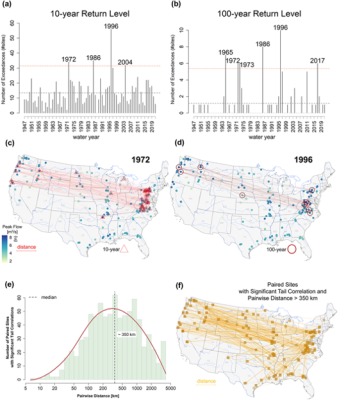Compound Continental Risk of Multiple Extreme Floods in the United States
It is important to know why past floods occurred in different parts of the United States in the same year and how they were connected to each other. This knowledge helps determine how likely it is for major annual floods to occur all across the country in the future. Consequently, an understanding of what drives such total annual flood losses each year and their relation to climate conditions is of strategic importance. This study uses a stochastic model for simulating multiple floods across the United States while preserving information as to their co-occurrence. The model also calculates the likelihood of combined flood losses, along with its uncertainty. The key patterns in the ocean and the atmosphere that lead to these widespread losses are then identified.
Understanding spatially correlated floods and modeling joint hazards associated with threshold exceedances across multiple locations is crucial for accurate estimation of continental-scale portfolio risk. An understanding of what drives such total annual flood losses each year and their relation to climate conditions is of strategic importance. The broader impact of this study is to establish a foundation that any country or region can use to evaluate the potential consequences of compound risk from joint extreme events.
We first demonstrate that patterns of multiple continental floods recur, posing a compound risk in the year of occurrence. We then utilize a non-parametric stochastic spatial simulator to model correlated floods across the continental United States and derive the first-of-its-kind aggregate flood exceedance or portfolio risk functions. The loss functions for aggregate continental flood hazard are estimated along with their uncertainty bounds for the 10- and 100-year flood return levels. We hypothesize that such compound effect could be a result of climate, and hence inferentially test the predictability of the losses using one or a set of potential atmospheric teleconnections.

